Overview
- Brief Narrative
- Ink wash drawing created by Karl Schwesig in 1948 in Dusseldorf. The drawing depicts Jewish women from Baden in Noe internment camp in France, where Schwesig was held from February to March 1941. After Hitler came to power in January 1933, Schwesig, a Communist, was arrested and imprisoned for 16 months. After his release in 1935, he lived in Antwerp, Belgium. On May 10, 1940, Germany invaded Belgium. Schwesig was arrested and sent to Vichy France, where he was held in St. Cyprien, Gurs, Noe, and Nexon internment camps. In 1943, he was sent to Ulmer Hoeh prison in Dusseldorf, where he was liberated by American forces in April 1945.
- Artwork Title
- Badenser Jüdinnen im Camp de Noé
- Date
-
creation:
1948
- Geography
-
depiction:
Noe (Concentration camp);
Noe (France)
creation: Dusseldorf (Germany)
- Credit Line
- United States Holocaust Memorial Museum Collection
- Signature
- front, lower left corner : Karl Schwesig
- Contributor
-
Artist:
Karl Schwesig
Subject: Karl Schwesig
- Biography
-
Karl Schwesig was born on June 19, 1898, in Gelsenkirchen, Germany. His father was a miner. From 1916 to 1918, Schwesig served in the German Army during the First World War (1914-1918). In 1918, Schwesig began studying at the Academy of Fine Arts in Dusseldorf. In 1921, he left the conservative academy and joined the Junge Rhineland artist group. In 1924, Schwesig cofounded the satirical magazine Die Peitsche (The Whip). The right wing Nazi Party was growing rapidly in popularity duirng the 1920s and Schwesig was an outspoken anti-Nazi. He joined the Communist Party in the late 1920’s.
Hitler came to power in Germany in January 1933 and the country was soon ruled by a Nazi dictatorship. On July 11, 1933, Schwesig was arrested for his anti-Nazi commentary. He was detained by the SA and interrogated for the names of colleagues who also resisted the Nazis. He was sent to Ulmer Höhe prison in Dusseldorf. In 1934, he was convicted of treason and served his sentence in Bendahl prison in Wuppertal. After his release on November 18, 1934, Schwesig was granted political asylum in Belgium and lived in Antwerp. In 1937, his German citizenship was revoked and his property in Germany was confiscated by the Nazi regime.
On May 10, 1940, Germany invaded Belgium. Schwesig was arrested and deported to St. Cyprien internment camp in Vichy France. In October, he was moved to Gurs internment camp after St. Cyprien was destroyed by flooding. In February 1941, he was transferred to Noé internment camp. In March 1943, he was sent to Nexon internment camp and classified as a politcal prisoner. In June, Schwesig was sent to Fort Romainville prison in Paris and in July to Ulmer Höhe prison in Dusseldorf. Throughout his imprisonment, Schwesig drew images of daily life in the camps. Schwesig was liberated in Ulmer Höhe after American forces captured Dusseldorf on April 17, 1945. The war ended when Germany surrendered on May 7. Schwesig stayed in Dusseldorf. He died, age 57, in 1955.
Physical Details
- Language
- German
- Classification
-
Art
- Category
-
Paintings
- Object Type
-
Watercolor painting (lcsh)
- Physical Description
- Drawing in ink wash on light brown paper depicting 4 female inmates and a guard in a concentration camp. There are 3 older women in the foreground, all with gaunt, wrinkled faces. They are wearing civilian dresses and heels. In the center is a woman walking to the left with a cane. She has thin legs, short hair, sunken cheeks, a large, pointed nose, and a large Adam’s apple at her neck. The woman on the left is walking forward. She has thin arms, sunken cheeks and a large hooked nose. The woman on the right is walking to the right, using an umbrella as a cane. She has wide legs, a large nose, and a pointed chin. In the background is a woman in a jacket and skirt and a uniformed guard with a helmet and rifle. There are 2 buildings with peaked roofs behind them. The ground is lightly shaded with ink wash. The title, artist’s name, and an inscription are written above the lower edge.
- Dimensions
- overall: Height: 22.500 inches (57.15 cm) | Width: 19.875 inches (50.483 cm)
- Materials
- overall : paper, ink, graphite
- Inscription
- front, lower left corner, pencil : für Lisbeth Kaufmann / bei ihren Besuch in Düsseldorf 1954 [for Lisbeth Kaufmann at their visit to Düsseldorf 1954]
front, lower right corner, handwritten, black ink : Badenser Jüdinnen im Camp de Noé (H.G.)
back, lower center, pencil : 92 / F82 – H.K.
Rights & Restrictions
- Conditions on Access
- No restrictions on access
- Conditions on Use
- No restrictions on use
Keywords & Subjects
Administrative Notes
- Legal Status
- Permanent Collection
- Provenance
- The watercolor painting was acquired by the United States Holocaust Memorial Museum in 1988.
- Record last modified:
- 2022-07-28 18:28:31
- This page:
- https://collections.ushmm.org/search/catalog/irn513898
Download & Licensing
In-Person Research
- By Appointment
- Request 21 Days in Advance of Visit
- Plan a Research Visit
- Request to See This Object
Contact Us
Also in Karl Schwesig collection
The collection consists of seventeen drawings, three watercolors, and 1 typed manuscript created by Karl Schwesig before and after the Holocaust when he was arrested in Dusseldorf, Germany, for anti-Nazi activity and for being a Communist, and incarcerated in multiple internment and prison camps in German and then France, as well as works relating to his wartime experiences done when he returned to Dusseldorf after the war.
Date: 1933-1949
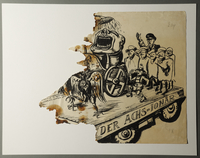
Karl Schwesig political cartoon mocking a Nazi parade
Object
Satirical drawing created by Karl Schwesig in February 1938 in Antwerp, with caricatures of soldiers, a Nazi officer, and Nazi eagles on a parade float. It is part of a series of eight political cartoons published in an illegal newspaper, the Kolner Rosenmontags-Zeitung (Cologne Rose Monday Newspaper). The newspaper was distributed at the Cologne Carnival on Rose Monday before Lent in early 1938. The printer in Cologne was unable to smuggle the dangerous drawings out of Germany, so he kept them in his shop, where they were damaged by a fire during the war. After Hitler came to power in January 1933, Schwesig, a Communist, was arrested and jailed for 16 months. After his release in 1935, he lived in Antwerp, Belgium. On May 10, 1940, Germany invaded Belgium. Schwesig was arrested and sent to Vichy France, where he was held in St. Cyprien, Gurs, Noe, and Nexon internment camps. In 1943, he was sent to Ulmer Hoeh prison in Dusseldorf, Germany, where he was liberated by American forces in April 1945.
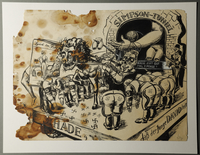
Cartoon by Karl Schwesig of Nazi soldiers bowing to a part human/part animal puppet
Object
Satirical ink drawing created by Karl Schwesig in February 1938 in Antwerp, depicting Nazi soldiers bowing to a marionette caricature of the Duke of Windsor, formerly Edward VIII of Great Britain, whose given name was David. He abdicated the throne in 1936 to marry Wallis Simpson. The couple accepted an invitation from Hitler's government and visited Nazi Germany in October 1937. It is from a series of eight political cartoons published in an illegal newspaper, the Kolner Rosenmontags-Zeitung (Cologne Rose Monday Newspaper). The newspaper was distributed at the Cologne Carnival on Rose Monday before Lent in early 1938. The printer in Cologne was unable to smuggle the dangerous drawings out of Germany, so he kept them in his shop, where they were damaged by a fire during the war. After Hitler came to power in January 1933, Schwesig, a Communist, was arrested and jailed for 16 months. After his release in 1935, he lived in Antwerp, Belgium. On May 10, 1940, Germany invaded Belgium. Schwesig was arrested and sent to Vichy France, where he was held in St. Cyprien, Gurs, Noe, and Nexon internment camps. In 1943, he was sent to Ulmer Hoeh prison in Dusseldorf, Germany, where he was liberated by American forces in April 1945.
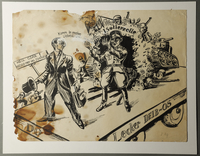
Drawing by Karl Schwesig satirizing the embrace of Fascism in France
Object
Drawing created by Karl Schwesig that was part of a series of 9 drawings entitled "Rosenmontag" representing early anti-Nazi satiric material. The image shows a Nazi military officer with arms outstretched standing on a platform (float?) with wheels beckoning to another man in formal attire and saying, "Komm in meine Liebeslauber." A cave labeled "I Solierzelle" and surrounded by tanks, guns, and soldiers is in the background. A sign to the left of the float says, "Heil Csar! Nieder Mit Uns Franzos."
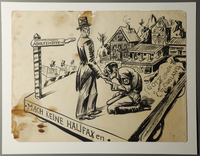
Satirical drawing by Karl Schwesig depicting Hitler greeting a British diplomat
Object
Satirical ink drawing created by Karl Schwesig in February 1938 in Antwerp, depicting Hitler kissing the hand of a British man in front of his home of Berchtesgaden. It is part of a series of eight satirical drawings published in an illegal newspaper, the Kolner Rosenmontags-Zeitung (Cologne Rose Monday Newspaper). The newspaper was printed in Cologne and distributed at the Cologne Carnival on Rose Monday before Lent in early 1938. The printer was unable to smuggle the dangerous drawings out of Germany, so he kept them in his shop, where they were damaged by a fire during the war. After Hitler came to power in January 1933, Schwesig, a Communist, was arrested and imprisoned for 16 months. After his release in 1935, he lived in Antwerp, Belgium. On May 10, 1940, Germany invaded Belgium. Schwesig was arrested and sent to Vichy France, where he was held in St. Cyprien, Gurs, Noe, and Nexon internment camps. In 1943, he was sent to Ulmer Hoeh prison in Dusseldorf, where he was liberated by American forces in April 1945.
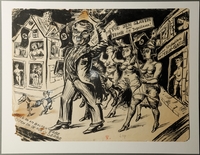
Satirical drawing by Karl Schwesig depicting the subjugation of Yugoslavia to Nazi Germany
Object
Satirical ink drawing created by Karl Schwesig in February 1938 in Antwerp, depicting a man and three scantily clad women protesting the Slavs. It is part of a series of eight satirical drawings published in an illegal newspaper, the Kolner Rosenmontags-Zeitung (Cologne Rose Monday Newspaper). The newspaper was printed in Cologne and distributed at the Cologne Carnival on Rose Monday before Lent in early 1938. The printer was unable to smuggle the dangerous drawings out of Germany, so he kept them in his shop, where they were damaged by a fire during the war. After Hitler came to power in January 1933, Schwesig, a Communist, was arrested and imprisoned for 16 months. After his release in 1935, he lived in Antwerp, Belgium. On May 10, 1940, Germany invaded Belgium. Schwesig was arrested and sent to Vichy France, where he was held in St. Cyprien, Gurs, Noe, and Nexon internment camps. In 1943, he was sent to Ulmer Hoeh prison in Dusseldorf, where he was liberated by American forces in April 1945.
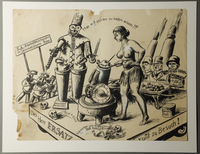
Satirical drawing by Karl Schwesig depicting Nazi followers as robots
Object
Satirical ink drawing created by Karl Schwesig in February 1938 in Antwerp, depicting a woman standing next to a robot and cannon. It is part of a series of eight satirical drawings published in an illegal newspaper, the Kolner Rosenmontags-Zeitung (Cologne Rose Monday Newspaper). The newspaper was printed in Cologne and distributed at the Cologne Carnival on Rose Monday before Lent in early 1938. The printer was unable to smuggle the dangerous drawings out of Germany, so he kept them in his shop, where they were damaged by a fire during the war. After Hitler came to power in January 1933, Schwesig, a Communist, was arrested and imprisoned for 16 months. After his release in 1935, he lived in Antwerp, Belgium. On May 10, 1940, Germany invaded Belgium. Schwesig was arrested and sent to Vichy France, where he was held in St. Cyprien, Gurs, Noe, and Nexon internment camps. In 1943, he was sent to Ulmer Hoeh prison in Dusseldorf, where he was liberated by American forces in April 1945.
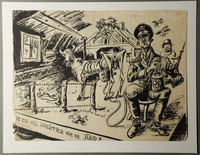
Satirical drawing by Karl Schwesig depicting Nazi soldiers as pigs
Object
Satirical ink drawing created by Karl Schwesig in February 1938 in Antwerp, depicting Himmler measuring the udder of a cow with a milking machine. It is part of a series of eight satirical drawings published in an illegal newspaper, the Kolner Rosenmontags-Zeitung (Cologne Rose Monday Newspaper). The newspaper was printed in Cologne and distributed at the Cologne Carnival on Rose Monday before Lent in early 1938. The printer was unable to smuggle the dangerous drawings out of Germany, so he kept them in his shop, where they were damaged by a fire during the war. After Hitler came to power in January 1933, Schwesig, a Communist, was arrested and imprisoned for 16 months. After his release in 1935, he lived in Antwerp, Belgium. On May 10, 1940, Germany invaded Belgium. Schwesig was arrested and sent to Vichy France, where he was held in St. Cyprien, Gurs, Noe, and Nexon internment camps. In 1943, he was sent to Ulmer Hoeh prison in Dusseldorf, where he was liberated by American forces in April 1945.
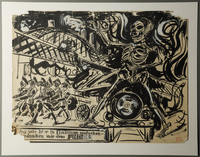
Pencil and ink drawing by Karl Schwesig depicting a skeletal Hitler atop an airplane
Object
Satirical ink drawing created by Karl Schwesig in February 1938 in Antwerp, depicting a skeleton with the face of Hitler entering the burning Cologne train station. It is part of a series of eight satirical drawings published in an illegal newspaper, the Kolner Rosenmontags-Zeitung (Cologne Rose Monday Newspaper). The newspaper was printed in Cologne and distributed at the Cologne Carnival on Rose Monday before Lent in early 1938. The printer was unable to smuggle the dangerous drawings out of Germany, so he kept them in his shop, where they were damaged by a fire during the war. After Hitler came to power in January 1933, Schwesig, a Communist, was arrested and imprisoned for 16 months. After his release in 1935, he lived in Antwerp, Belgium. On May 10, 1940, Germany invaded Belgium. Schwesig was arrested and sent to Vichy France, where he was held in St. Cyprien, Gurs, Noe, and Nexon internment camps. In 1943, he was sent to Ulmer Hoeh prison in Dusseldorf, where he was liberated by American forces in April 1945.
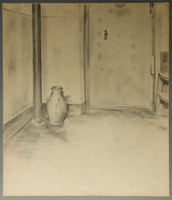
Satirical drawing by Karl Schwesig depicting a German prison
Object
Pencil drawing of a jug created by Karl Schwesig in 1933 while he was a prisoner in Ulmer Hoeh prison in Dusseldorf. After Hitler came to power in January 1933, Schwesig, a Communist, was arrested and imprisoned for 16 months. After his release in 1935, he lived in Antwerp, Belgium. On May 10, 1940, Germany invaded Belgium. Schwesig was arrested and sent to Vichy France, where he was held in St. Cyprien, Gurs, Noe, and Nexon internment camps. In 1943, he was sent to Ulmer Hoeh prison in Dusseldorf, where he was liberated by American forces in April 1945.
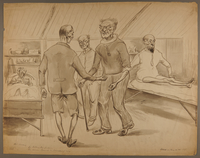
Watercolor created by Karl Schwesig postwar based on his experiences in an internment camp
Object
Ink wash drawing created by Karl Schwesig in 1948 in Dusseldorf. The drawing depicts the hospital in Noe internment camp in France, where Schwesig was held from February to March 1941. After Hitler came to power in January 1933, Schwesig, a Communist, was arrested and imprisoned for 16 months. After his release in 1935, he lived in Antwerp, Belgium. On May 10, 1940, Germany invaded Belgium. Schwesig was arrested and sent to Vichy France, where he was held in St. Cyprien, Gurs, Noe, and Nexon internment camps. In 1943, he was sent to Ulmer Hoeh prison in Dusseldorf, where he was liberated by American forces in April 1945.
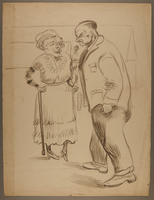
Drawing created by Karl Schwesig postwar based upon his experiences as a political prisoner
Object
Ink wash drawing created by Karl Schwesig in 1948 in Dusseldorf. The drawing depicts people in Noe internment camp in France, where Schwesig was held from February to March 1941. After Hitler came to power in January 1933, Schwesig, a Communist, was arrested and imprisoned for 16 months. After his release in 1935, he lived in Antwerp, Belgium. On May 10, 1940, Germany invaded Belgium. Schwesig was arrested and sent to Vichy France, where he was held in St. Cyprien, Gurs, Noe, and Nexon internment camps. In 1943, he was sent to Ulmer Hoeh prison in Dusseldorf, where he was liberated by American forces in April 1945.
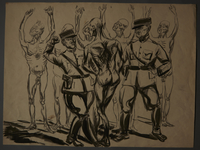
Drawing created by Karl Schwesig postwar depicting a beating he witnessed in a concentration camp
Object
Ink wash drawing created by Karl Schwesig in 1948 in Dusseldorf. The drawing depicts two guards beating a nude inmate in Noe internment camp in France, where Schwesig was held from February to March 1941. After Hitler came to power in January 1933, Schwesig, a Communist, was arrested and imprisoned for 16 months. After his release in 1935, he lived in Antwerp, Belgium. On May 10, 1940, Germany invaded Belgium. Schwesig was arrested and sent to Vichy France, where he was held in St. Cyprien, Gurs, Noe, and Nexon internment camps. In 1943, he was sent to Ulmer Hoeh prison in Dusseldorf, where he was liberated by American forces in April 1945.
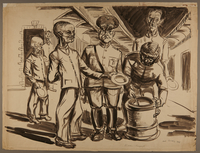
Watercolor created by Karl Schwesig with a scene of soldiers and inmates in a concentration camp
Object
Ink wash drawing created by Karl Schwesig in 1948 in Dusseldorf. The drawing depicts inmates receiving soup in Noe internment camp in France, where Schwesig was held from February to March 1941. After Hitler came to power in January 1933, Schwesig, a Communist, was arrested and imprisoned for 16 months. After his release in 1935, he lived in Antwerp, Belgium. On May 10, 1940, Germany invaded Belgium. Schwesig was arrested and sent to Vichy France, where he was held in St. Cyprien, Gurs, Noe, and Nexon internment camps. In 1943, he was sent to Ulmer Hoeh prison in Dusseldorf, where he was liberated by American forces in April 1945.
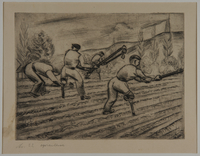
Etching by Karl Schwesig of 3 inmates at work under an armed guard in a prison camp
Object
Etching created by Karl Schwesig between 1948 and 1949 in Dusseldorf. The drawing depicts three inmates missing limbs and is based on Schwesig’s experiences in internment camps in Vichy France. After Hitler came to power in January 1933, Schwesig, a Communist, was arrested and imprisoned for 16 months. After his release in 1935, he lived in Antwerp, Belgium. On May 10, 1940, Germany invaded Belgium. Schwesig was arrested and sent to Vichy France, where he was held in St. Cyprien, Gurs, Noe, and Nexon internment camps. In 1943, he was sent to Ulmer Hoeh prison in Dusseldorf, where he was liberated by American forces in April 1945.
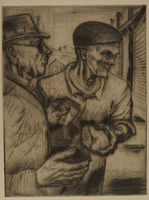
Etching by Karl Schwesig showing inmates bartering bread and cigarettes in a concentration camp
Object
Etching created by Karl Schwesig between 1948 and 1949 in Dusseldorf. The drawing depicts an inmate trading cigarettes for bread with a civilian and is based on Schwesig’s experiences in internment camps in Vichy France. After Hitler came to power in January 1933, Schwesig, a Communist, was arrested and imprisoned for 16 months. After his release in 1935, he lived in Antwerp, Belgium. On May 10, 1940, Germany invaded Belgium. Schwesig was arrested and sent to Vichy France, where he was held in St. Cyprien, Gurs, Noe, and Nexon internment camps. In 1943, he was sent to Ulmer Hoeh prison in Dusseldorf, where he was liberated by American forces in April 1945.
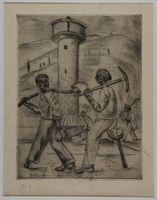
Etching by Karl Schwesig showing one legged inmates going to work in a concentration camp
Object
Etching created by Karl Schwesig between 1948 and 1949 in Dusseldorf. The drawing depicts two inmates missing legs and is based on Schwesig’s experiences in internment camps in Vichy France. After Hitler came to power in January 1933, Schwesig, a Communist, was arrested and imprisoned for 16 months. After his release in 1935, he lived in Antwerp, Belgium. On May 10, 1940, Germany invaded Belgium. Schwesig was arrested and sent to Vichy France, where he was held in St. Cyprien, Gurs, Noe, and Nexon internment camps. In 1943, he was sent to Ulmer Hoeh prison in Dusseldorf, where he was liberated by American forces in April 1945.
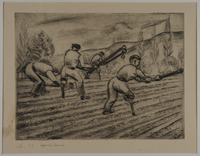
Ink drawing by Karl Schwesig showing one legged inmates working in a field in a concentration camp
Object
Etching created by Karl Schwesig between 1948 and 1949 in Dusseldorf. The drawing depicts four inmates working in a field, three of whom are missing a leg, and is based on Schwesig’s experiences in internment camps in Vichy France. After Hitler came to power in January 1933, Schwesig, a Communist, was arrested and imprisoned for 16 months. After his release in 1935, he lived in Antwerp, Belgium. On May 10, 1940, Germany invaded Belgium. Schwesig was arrested and sent to Vichy France, where he was held in St. Cyprien, Gurs, Noe, and Nexon internment camps. In 1943, he was sent to Ulmer Hoeh prison in Dusseldorf, where he was liberated by American forces in April 1945.
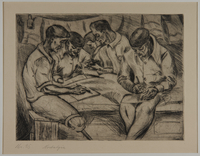
Etching by Karl Schwesig showing a fellow prisoner writing in a concentration camp
Object
Etching created by Karl Schwesig between 1948 and 1949 in Dusseldorf. The drawing depicts five inmates writing, three of whom are missing a limb, and is based on Schwesig’s experiences in internment camps in Vichy France. After Hitler came to power in January 1933, Schwesig, a Communist, was arrested and imprisoned for 16 months. After his release in 1935, he lived in Antwerp, Belgium. On May 10, 1940, Germany invaded Belgium. Schwesig was arrested and sent to Vichy France, where he was held in St. Cyprien, Gurs, Noe, and Nexon internment camps. In 1943, he was sent to Ulmer Hoeh prison in Dusseldorf, where he was liberated by American forces in April 1945.
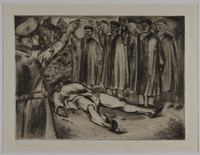
Satirical etching by Karl Schwesig showing men in academic robes saluting a corpse
Object
Etching created by Karl Schwesig in 1949 in Dusseldorf, depicting six men and a military officer saluting over a corpse. After Hitler came to power in January 1933, Schwesig, a Communist, was arrested and imprisoned for 16 months. After his release in 1935, he lived in Antwerp, Belgium. On May 10, 1940, Germany invaded Belgium. Schwesig was arrested and sent to Vichy France, where he was held in St. Cyprien, Gurs, Noe, and Nexon internment camps. In 1943, he was sent to Ulmer Hoeh prison in Dusseldorf, where he was liberated by American forces in April 1945.
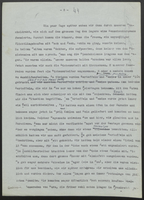
Karl Schwesig manuscript
Document
Karl Schwesig's manuscript is not formally titled but has been referred to as "Pyrenäenbericht." It is divided into five sections: untitled (39 pages), "Noé" (8 pages), "Zwischensatz [Noé]" (10 pages), "Nexon" (14 pages), and "Fort Romainville, Kaserne" (11 pages). The manuscript relates his internment as a political prisoner in Holocaust-era concentration camps in France including Noé, Gurs, Saint-Cyprien, Nexon, as well as the Fort de Romainville prison in Paris and the Ulmer Höhe prison in Düsseldorf. It describes the scenery in the Pyrenees, camp conditions, food, his health, the treatment he received, fellow prisoners, daily life, and extraordinary events. The manuscript is accompanied by a map tracing Schwesig's Holocaust era itinerary from Düsseldorf, through Belgium and France, and back to Düsseldorf.



